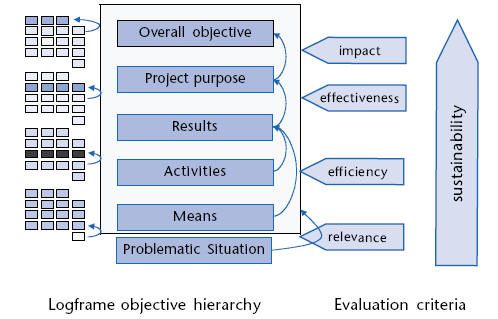
Outcome/impact evaluation: Effectiveness
How do we Evaluate Programmes?
Evaluation Typologies with respect to to the
managerial level of the programme cycle management
See aslo: Aid effectiveness: Evaluating the impact of aid
Relevance - the extent to which the project or programme objectives are valid and appropriate for the priorities and needs of the beneficiaries .
Effectiveness - the extent to which the objectives are being achieved as a result of the project or programme itself, and the extent to which other factors are influencing the results. (consideration of the wider context in which projects and programmes operate should be an integral part of the evaluation).
Efficacia: giudica in che misura i risultati prodotti abbiano contribuito al raggiungimento dell'obiettivo specifico del progetto e in che misura le supposizioni si siano verificate e le condizioni esterne abbiano influito sull'andamento del progetto.
Link between Evaluation Criteria and the Logframe

Articulating the Theory of Change: Program Logic, Program Theory, and Logical Framework
The fourth dimension is to be able to reconstruct, test, and work with the underlying program logic, program theory, and logical frameworks. The underlying logic and theory of a program are important topics for evaluations, whether it is during the ex ante or the ex post stage of a study.
Therefore, when the study is planned, attention must be paid to the question when and how underlying logic and theory will be reconstructed and tested.
You can use visual techniques to help you visualize and organize the key components and interactions of a project, program, or policy. The techniques attempt to show the cause and effects of projects, programs, or policies.
Some of the ways to visualize use models. Models are diagrams or some other type of visual that attempt to show the links in a chain of reasoning about "what causes what," in relationship to the desired outcome or goal. The desired outcome or goal is usually shown as the last link in the model.
The value of a model is that it visually conveys beliefs about why the evaluation is likely to succeed. Because it is visual, it can usually be more easily remembered. A model can also specify the various components of a program and their relationships to each other. Donors provide resources to enable an organization to engage in activities in order to achieve specific goals and objectives. The resources, activities, results, and impacts are inter-related.
In some cases, there may be an existing theory of change. If so the evaluator needs to review it carefully. In many cases, it will be necessary to refine or rework the existing theory of change.
If no theory of change exists, the evaluator will need to create one.
See aslo:
Aid effectiveness: Evaluating the impact of aid
Other resources: